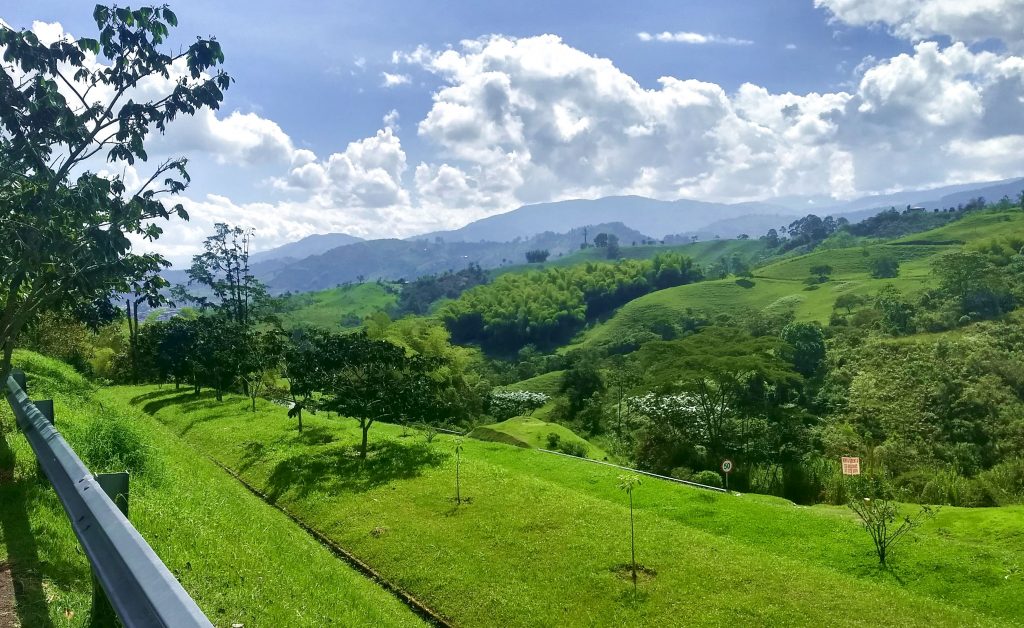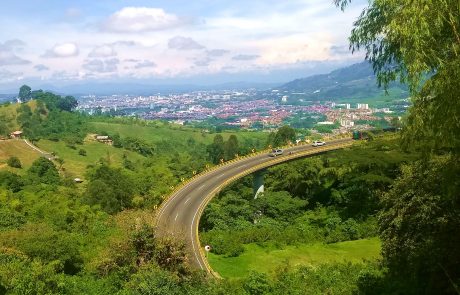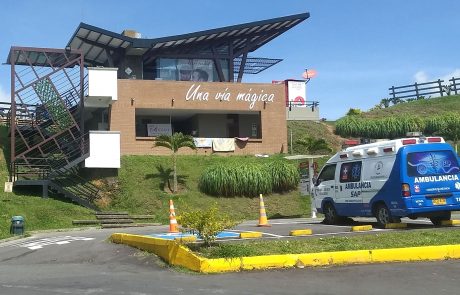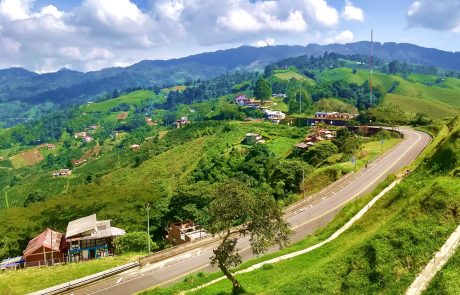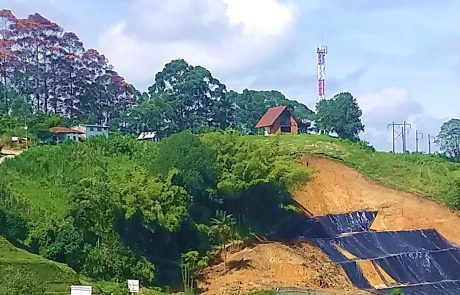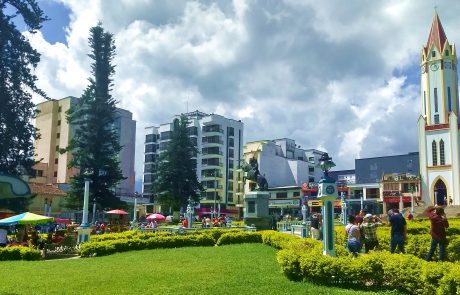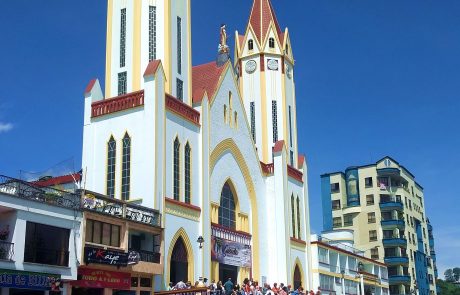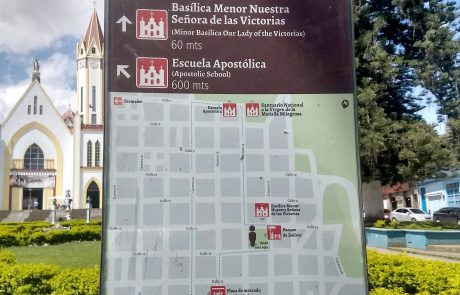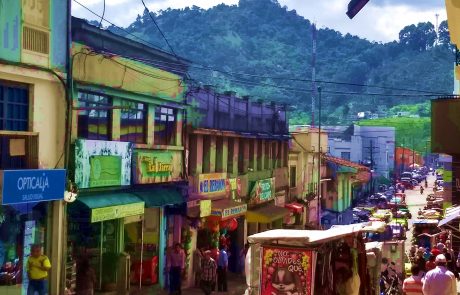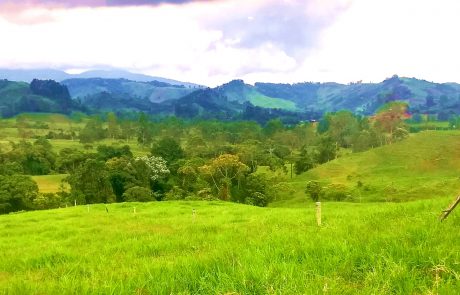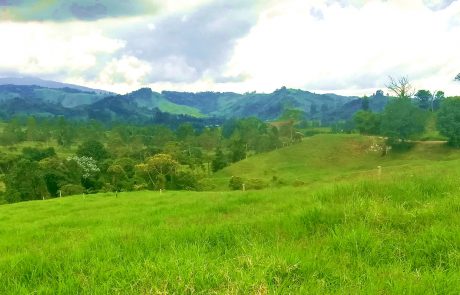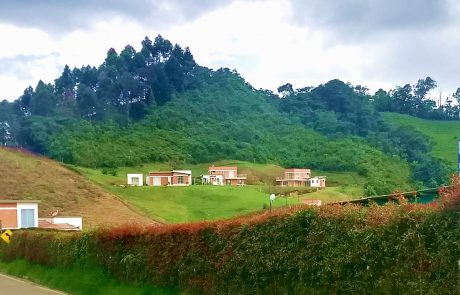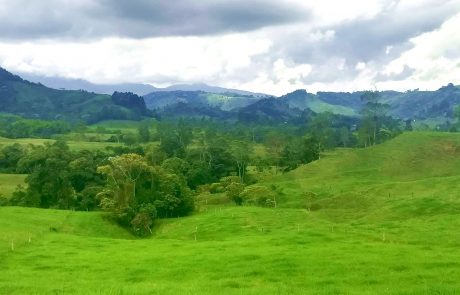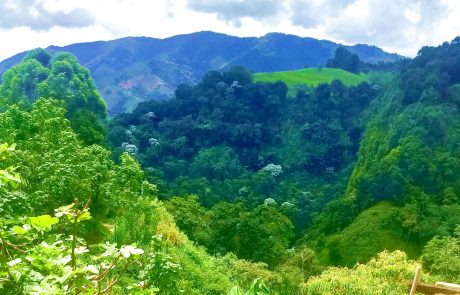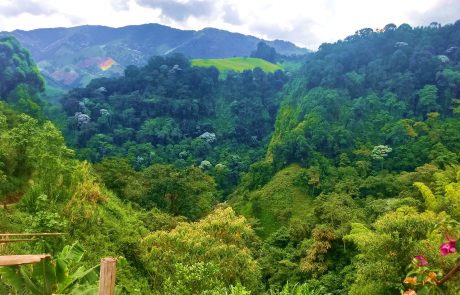July 2019
 Santa Rosa de Cabal — hereafter simply Santa Rosa — is a stone’s throw away from Pereira as the crow flies but there’s considerable upthrust involved. You have to go over the top of the mountain chain that encircles Pereira to get there. Such opportunities for expansive vistas of the Coffee Triangle’s sumptuous countryside do not go unappreciated by Yours Truly, so when a friend with a motorcycle offered to take me I jumped at the opportunity. I’m glad we decided to go early — the weather was lovely. An hour after I got home it started to pour down rain in quantities that can only be called biblical. I thanked my lucky stars I wasn’t on the back of the motorcycle when the rain came. That would’ve been a major oy gevalt.
Santa Rosa de Cabal — hereafter simply Santa Rosa — is a stone’s throw away from Pereira as the crow flies but there’s considerable upthrust involved. You have to go over the top of the mountain chain that encircles Pereira to get there. Such opportunities for expansive vistas of the Coffee Triangle’s sumptuous countryside do not go unappreciated by Yours Truly, so when a friend with a motorcycle offered to take me I jumped at the opportunity. I’m glad we decided to go early — the weather was lovely. An hour after I got home it started to pour down rain in quantities that can only be called biblical. I thanked my lucky stars I wasn’t on the back of the motorcycle when the rain came. That would’ve been a major oy gevalt.
In the United States the proximity of Santa Rosa would make of it a bedroom community of Pereira. I expected the same thing to hold true here. It’s not quite the case, although some people (my friend among them) live in Santa Rosa and work in Pereira. It turns out that Santa Rosa is fairly independent and has a large population of older people. Some of them are expats, so I heard, although I was the only white guy with an accent I came across in my foray through the town. There are others, Colombians who worked abroad for many years and returned to retire in their native nook. I was aware as I walked about the town that the number of elderly people is much higher than is the case in Pereira. Between expat retirees and local people of a certain age they seem almost to make up the majority. In Pereira it’s twenty-somethings who rule the roost.
The mountain you go over to reach Santa Rosa is the one I see every day from the balcony of my apartment. At the distance from which I view it on my balcony it seems impressive enough. Once you’re on top of it looking out over the countryside you realize that you are WAY up there. Fortunately there’s a cool viewpoint with a nice cafe so you can take in the vistas. Without further ado, some pics:
The sign explains the name of the place: Tambo. A tambo was the equivalent of a rest stop on an interstate for coffee farm workers (arriendos) moving from one farm to another. There’s a shack, you have some coffee (or something stronger if the mood strikes you), take the weight off your feet for a while then trundle on to the next job. Obviously the facilities at the modern tourist tambo are quite posh. If you get it into your head to have a myocardial infarction while enjoying the fine views, there’s even an ambulance to provide quick and efficient service to the nearest hospital. The sign on the building says, “A magical route.” All very well and good, but you never know when magic will fail you, so there’s the ambulance at the ready. And believe me, an ambulance driver in Colombia takes no prisoners. The only faster way to get to a healthcare facility is by magic, which if you’re in an ambulance is obviously in short supply. Stick with the Colombian driver, that’s my advice.
The last pic is significant because it reveals the geology of the mountains. Even at this high elevation you see that the composition of the mountain is largely soil, not stone. The area with the black plastic is a landslide site caused by heavy rain. Obviously without a stone substrate to hold things in place soil will soak up rain and start to move. If things weren’t at such a steep pitch that point of soil mechanics might prove less troublesome, but things are at a steep pitch everywhere in the Coffee Triangle and the rain is at times torrential so landslides are a common occurrence. Curiously enough the same was true in the mountains of Panay where I lived in the Philippines. I come from a place in the States where mountains are huge chunks of granite thrust up into the air by the collision of tectonic plates. Soil is no more than a thin layer on top of solid rock, so the word “landslide” never enters our vocabulary in a practical sense. In the Coffee Triangle the word obviously needs to be taken seriously. The pic is clear evidence of that fact.
Let me get one thing out of the way at this early point in the post. The major claim to fame of Santa Rosa is hot springs (termales in Spanish), the main reason most people find Santa Rosa a Big Deal. Some add in the local sausage (chorizo santarrosano), but that’s kind of an afterthought. The hot springs are definitely the major attraction and they’re 20km outside the town, so some people sail through the town without stopping as they head to the termales. I haven’t been there and don’t have any plans to go in the near future. The pics are lovely but it costs a goodly amount to get in and it’s a family place so there are tons of rugrats running around screaming. Homey don’t play that. My experience of Santa Rosa involves the town and the splendid countryside surrounding it. After nearly a month in busy, noisy Pereira going to a town where in five minutes you’re out in rural countryside was a blessing. The countryside was my major focus. Consider that a heads up for the pics you’ll see below. So no termales here, sorry, kids. You can get pics enough of them on Google if those are your druthers. There are videoblogs of visits to the hot springs on YouTube, too, if that takes your fancy. I’m useless to you in that regard and will likely remain so for a good while.
I did give due attention to the town itself. It’s an example of what happens to a standard-issue colonial town that goes suburban. The other towns I’ve visited have not gone through that transformation because they’re too far away from a city. Santa Rosa is 20 minutes from Pereira so it’s within its urban gravitation range. You can tell that immediately from the pics of the town square, with high-rise office buildings well in view, something you’d never see in a million years in a place like Filandia or Marsella. Here’s the evidence:
Things have remained fairly colonial on the main street, but there’s none of the colorful architectural tradition you find in other historical towns. It’s strictly business, thank you very much, although not without its tongue-in-cheek elements. The rest of the town is indistinguishable in my opinion from the backstreets of Pereira. The same kind of stucco buildings, the same kind of shops, just fewer twenty-somethings going by in a tear on a motorcycle and fewer buses plying the narrow streets. It’s a pleasant place to live, I’m sure, because everything is in close reach and the noise is minimal. Here are some pics of the town:
The second pic is the tongue-in-cheek element I mentioned. There’s another bridal pair in a window behind the palm tree. I found it very funny to see the mannequins dolled up and hanging out on the balcony as though they were viceregal personages surveying the peasantry. I was there on a Sunday and things were humming. We beat the after-church crowd, thank goodness, because it gets really busy in the afternoon so I’m told. Even in the morning hours walking down the sidewalk was like dancing salsa in the attempt to avoid collision with other pedestrians. After about an hour walking the streets I was ready to head out of town. That’s when the fun part really began.
The countryside of the Eje Cafetero is various but it’s been under cultivation for centuries and so shows some similarity between the regions. The amount of cleared land is large. If you consider that the native forest is so thick you have to cut your way through it with a machete you can see how English the landscape looks in its present state — huge swaths of green pasture everywhere. It’s like the Downs with a few more hills and bit more forest. I have nothing against pastureland, perish the thought — I’m as fond of butter and whipped cream as the next person and they have to come from somebody’s cows, don’t they. Of course they do. So as a consumer of such delights I keep my mouth shut when it comes to pasture supporting a herd of dairy cattle. No, it’s not natural. It should be a tangle of various tree species and completely overrun by the native bamboo species, Guadua angustifolia. But it’s lovely in a rural English way and I’m happy to live and let live — and to find a ready supply of butter at the supermarket.
The pics I have are of countryside only five minutes outside town. I’ll let the pictures do the talking since they have a thousand words on me.
There was a haze in the air that day — something almost axiomatic with me and picture taking, as I’ve mentioned before. But no matter, you get the idea. The pics of the first two rows require special seeing. The countryside contains many different perspectives because of the mountainous terrain. We’re lazy observers most of the time, we see the foreground and consider the job done and dusted. But I ask you to look carefully at the background and to accord it the same level of visual importance as the foreground. The result gets you closer to the lived sense of the countryside, which communicates all these levels of depth because that’s the reality there before you. I had a similar experience this morning standing on my balcony looking at the mountain you cross to get to Santa Rosa. The morning was clear and behind the mountain I’m familar with loomed another even higher range at greater distance. That’s the magic of the countryside here: the way in which it reveals itself differently at different times, with great depth to the image when the conditions are right. I feel like I’m watching a moving picture rather than looking at static landscape. The countryside seems almost like something alive that changes within a short time. It’s impossible to capture that sense in a still picture, but if you look into the distance you’ll get a sense of what I mean.
By the way, if you’re reading this post on your phone my apologies for the cropped landscapes, they look much better on a desktop. I’ll see if I can’t mend my ways and achieve parity between the mobile and desktop site versions since I know gearing things toward desktop use just shows me up as a dinosaur. You’re probably playing Angry Birds while glancing at the pics, too, aren’t you. I may be old but I’m not stupid. 🙂
The bottom row of pics comes from a single spot where the contour of the land and the loveliness of the vegetation it supports left me in a kind of meditative state where I just wanted to look and look and not stop looking. I can name only a few of the tree species — among them my new best friend Cecropia peltata, the “yarumo blanco” I mentioned in detail in the earlier post on Filandia. If you consider the palette of greens in the landscape the variety is amazing. The Cecropia‘s accent of color brings out the variety for me because it lifts my attention to the higher end of the spectrum. Once again, the shifting contours of the landforms bring a visual w0w moment. The eye may fix on one spot but will soon be drawn to another by the shift in contour and color. This is the un-English aspect of the thoroughly tamed countryside I find so fascinating. It’s pure Colombia, pure Andes, and wholly lovely. I didn’t expect to find such landscapes here, steeped as I am in the images of the Andes purveyed by American media. You expect towering mountains with snow on the top, bare rock and a height that’s enough to give pause to a veteran of Everest. That may well be true of the high Andes in Chile, but I had no idea there are huge swaths of this beautiful and Cotswold-like countryside throughout the Cordilleras here in Colombia. What a delight to spend time in it. I never get enough no matter how often I hang out with it. It’s my new BFF.
My visit to Santa Rosa was short but memorable. The images I have in mind of the countryside comfort me now as they rise in my memory — for example when a big truck goes past on the busy street I live on and makes the windows rattle. I hold my Zen spot by thinking of the countryside outside Santa Rosa with its sculptural contours and lovely greens.
Oh and by the way, I tried the sausage. It’s got Oscar Mayer beat hands down. 🙂
